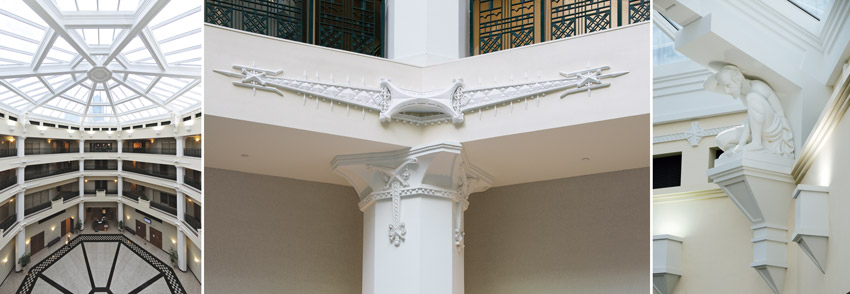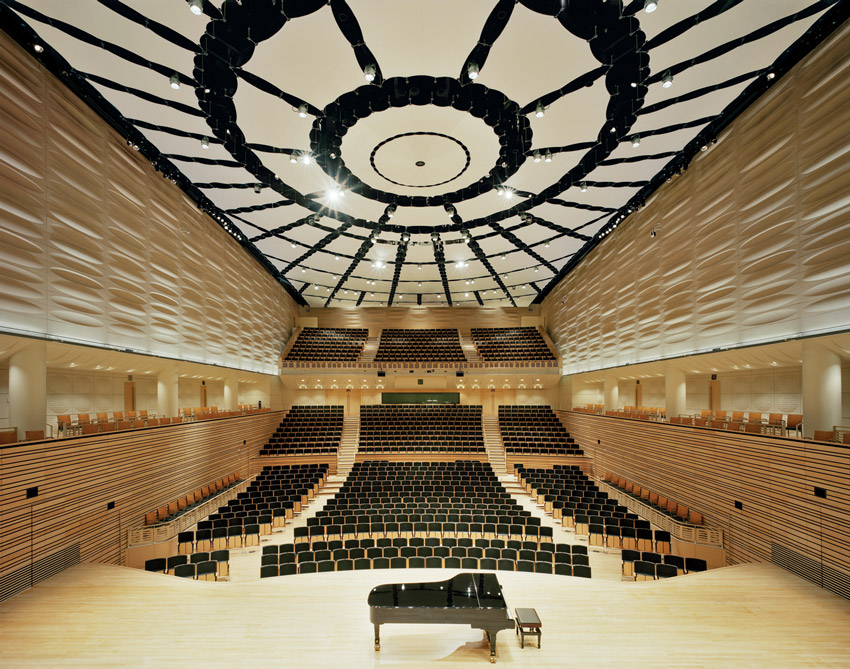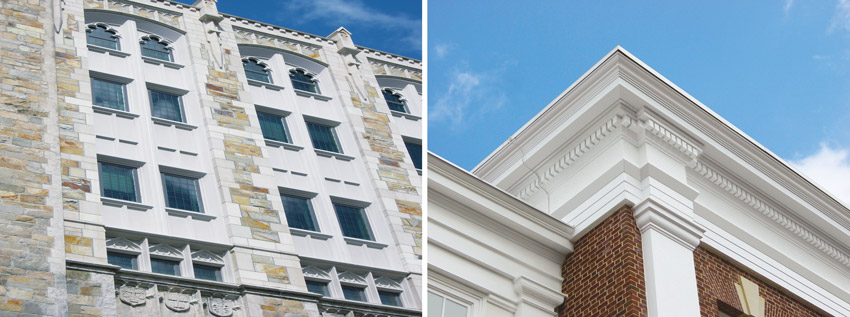Architectural Castings for Walls and Ceilings
Types of Architectural Castings
There are several common types of architectural castings that are differentiated primarily on the basis of their material makeup. Each type is characterized with somewhat different properties, characteristics, and suitability for applications. They can be categorized as follows:
- Glass fiber-reinforced gypsum (GRG), which is suitable for interior applications on walls and ceilings.
- Glass fiber-reinforced concrete (GFRC), which is primarily used for exteriors but can also be used for interior applications.
- Glass fiber-reinforced polyester resin (FRP), which is a durable choice for exterior applications.
- Cast stone, which is an interior molded stone composite appropriate for interior uses only.
Each of these four types and their attributes are discussed further in the following sections.
Glass Fiber-Reinforced Gypsum (GRG)
As the name suggests, glass fiber-reinforced gypsum (GRG) is a composite material consisting of alpha gypsum cement that is mixed with appropriate amounts of water and reinforced with glass fibers. GRG has become the type of architectural casting that is most often used for interior walls and ceilings in large part because it is an economical, lightweight, and durable replacement for traditional plaster detailing. As a building product, it complies with the testing requirements of ASTM C-1355/C-1355M: Standard Specification for Glass Fiber-Reinforced Gypsum Composites and ASTM C-1381: Standard Specification for Molded Glass Fiber-Reinforced Gypsum Parts. From a fire-safety standpoint, GRG also readily meets the code requirements for burning characteristics for Class A fire performance per ASTM E84: Standard Test Method for Surface Burning Characteristics of Building Materials.
Beyond its proven use as a building material, architectural castings made from GRG bring a number of appealing general characteristics. Foremost is the fact that it can be easily cast into any shape or compound curve due to its liquid base that conforms directly to the casting mold. As a material, it sets fast, which means it can keep up with or even reduce construction time schedules. The resulting castings are quite durable and relatively lightweight, coming in at only 2–3+ pounds per square foot, depending on the casting shape and degree of reinforcement.

Glass fiber-reinforced gypsum (GRG) castings provide great design flexibility and opportunity for details, as shown here at the St. James Building in Jacksonville, Florida.
Once the GRG castings are sent to the project site, they are usually quite easy to install since they have been made specifically to fit in selected locations on walls or ceilings. Adhesive or mechanical fastening, or a combination, can be employed as appropriate to secure the castings permanently in place. Like plaster products, the standard GRG surface finish is an unfinished, paint grade surface. That means they can be field painted or coated to achieve any desired color or texture. That can include smooth, continuous looks or specialty finishes to replicate the look of natural materials such as wood, stone, or metals, but all at a lower cost than using those actual materials.
In addition to decorative purposes, GRG has been used for other reasons. In a general interior lighting scheme, it can be formed into light coves or other features to direct, diffuse, or disperse light in an interior space. In spaces that need acoustic treatments to achieve a desired reverberation rate, the density can be adjusted by customizing the thickness to 1⁄2 inch or 3⁄4 inch instead of the standard 3⁄16 inch. Acousticians are increasingly recognizing this capability and finding it a good material with which to work.

GRG has become recognized for providing desirable acoustic properties related to reverberation, such as in this auditorium at Experimental Media and Performing Arts Center in Troy, New York.
Since GRG architectural castings are gypsum based, they are very low maintenance. This makes them well suited for many typical applications on interior ceilings and walls, such as decorative ceiling and wall panels, coffers, domes, light coves, vaults, and moldings. They can also be used as decorative column covers over structural steel columns in many cases. Virtually any interior spot that needs some added detail or design features can likely be addressed by using GRG architectural castings.
Glass Fiber-Reinforced Concrete (GFRC)
The use of precast concrete features on building exteriors such as cornices, copings, and similar items has been common for some time, particularly on masonry buildings. Using glass fiber-reinforced concrete (GFRC) instead of conventional precast moves the use of this type of architectural casting into new and rather creative possibilities. Since GFRC is a lightweight portland cement composite material that is reinforced with glass fibers, it is an economical and more diverse alternative to precast concrete. GFRC has been used as an architectural building material in North America since the 1970s, though its use in Eastern Europe extends back to the 1940s. It is typically an exterior product but can also be used for interior applications.
The specific makeup of GFRC materials consist of portland cement, sand, aggregates, alkali-resistant fiber, polymer, additives, and water. Since it is concrete based, it also readily achieves Class A fire performance per ASTM E84. Although it is typically cast as a ½-inch material, the reinforced concrete makeup means that it is durable in that it will not rot, rust, or suffer unduly from abuse or vandalism. It readily can withstand weather exposure over time. While these are all appropriate and desirable characteristics for exterior use, it is also safe for interior use since the finished product is odorless and emission free. In terms of structural impact, GFRC castings typically weigh only 6–8+ pounds per square foot, which can impose less dead load on a building than conventional precast concrete. (Note that weight between different castings vary depending on details, thickness, reinforcement, etc.)

Glass fiber-reinforced concrete (GFRC) can be cast into a variety of exterior shapes, including entire wall panels or cornice/frieze details across large sections of a facade.








